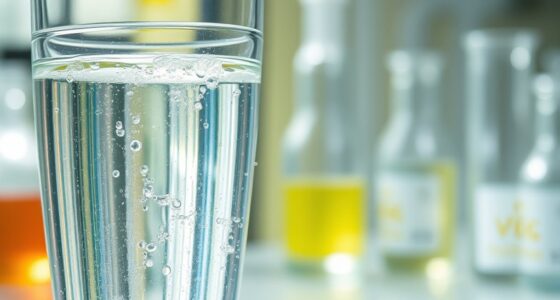If you want a quick understanding of hardness versus TDS, think of hardness as the minerals like calcium and magnesium dissolved in your water, which can cause buildup and damage appliances. TDS, on the other hand, measures all dissolved substances, including salts and organic matter, affecting taste and purity. Both impact your water quality, but they are measured differently. Keep exploring to learn how these differences influence your water treatment options and overall water health.
Key Takeaways
- Hardness measures calcium and magnesium minerals causing scale, while TDS indicates all dissolved substances affecting water taste and purity.
- Hard water can damage appliances, but it’s safe; high TDS can impact safety, taste, and odor.
- Measurement tools include test strips or digital meters for both hardness and TDS, guiding treatment decisions.
- Water softeners remove minerals causing hardness; filtration systems reduce TDS and improve water quality.
- Regular testing and maintenance ensure effective water treatment, extending appliance lifespan and ensuring better-tasting, safer water.
What Is Water Hardness?
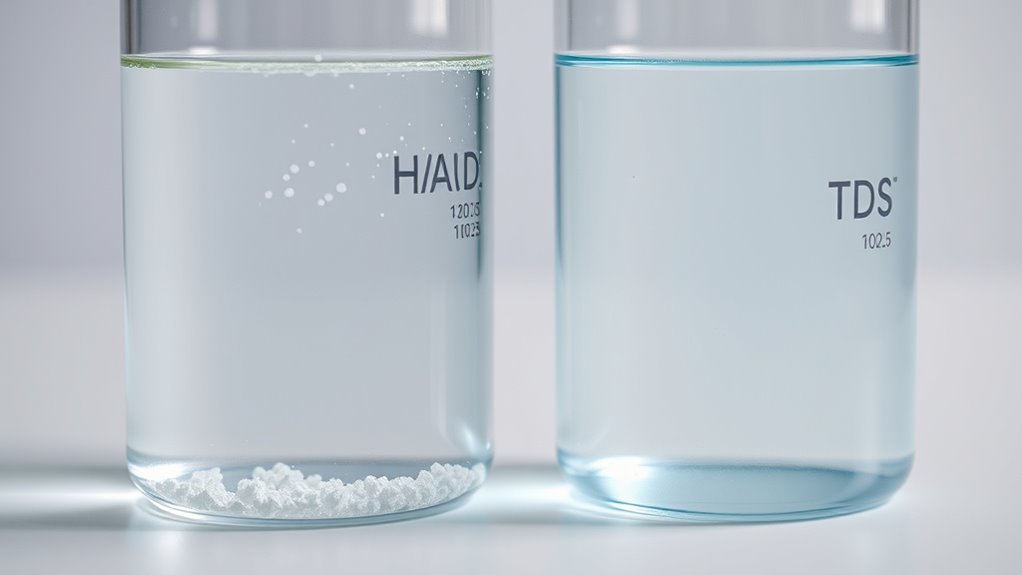
Water hardness refers to the amount of dissolved minerals, mainly calcium and magnesium, in your water. When these minerals are high, they can cause issues like mineral deposits on fixtures, appliances, and inside pipes. To combat this, water softening is often used, which replaces calcium and magnesium ions with sodium or potassium ions, reducing the minerals that cause hardness. Hard water is not harmful to your health but can lead to buildup that affects water flow and appliance efficiency. Mineral deposits from hard water can clog pipes and reduce the lifespan of appliances like water heaters and dishwashers. Understanding water hardness helps you decide whether you need water softening solutions to prevent mineral deposits and protect your plumbing and appliances. Additionally, **water softening** techniques can improve the longevity of your plumbing system and overall water quality by effectively managing mineral levels.
Understanding TDS (Total Dissolved Solids)
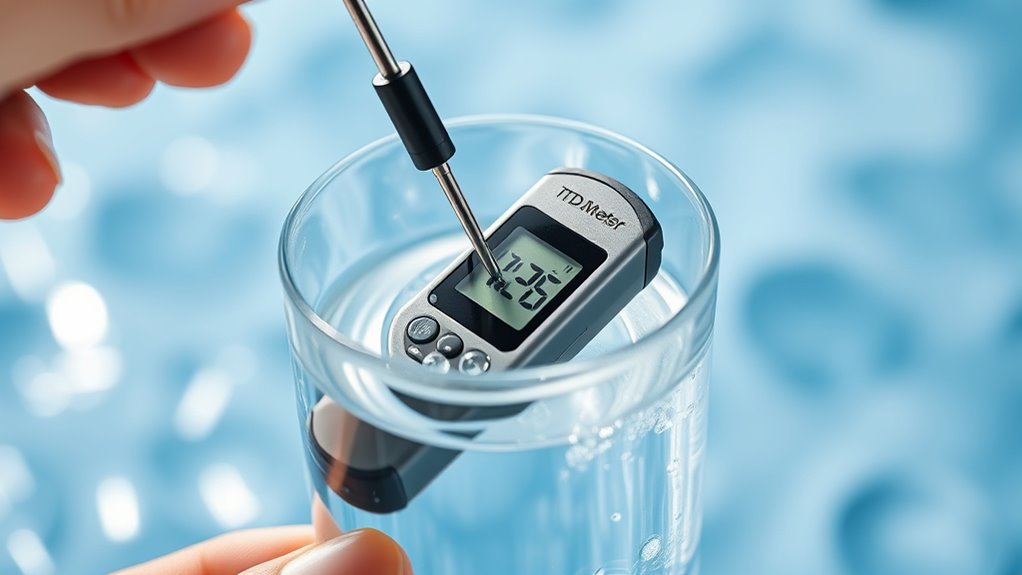
Understanding TDS helps you see what’s dissolved in your water, including minerals, salts, and organic matter. These solids come from natural sources, pollution, or treatment processes. Unlike hardness, TDS measures overall dissolved substances, not just minerals that cause scale. HEPA filtration is unrelated to TDS but is an example of how water quality can be improved by removing specific particles.
What TDS Measures
Total Dissolved Solids (TDS) measure the combined amount of inorganic salts, minerals, and trace elements present in a liquid. When evaluating water quality, TDS provides a quick indicator of how pure or contaminated the water is. High TDS levels often mean more dissolved substances, which can affect water taste, odor, and safety. In water purification, understanding TDS helps determine if the water meets water quality standards set by health authorities. Low TDS generally indicates cleaner water, but some dissolved minerals are essential for taste and health. Knowing what TDS measures allows you to assess whether water is suitable for drinking, industrial use, or other purposes. It’s a simple, effective way to gauge overall water quality at a glance.
TDS Sources in Water
TDS sources in water come from a variety of natural and human-made origins. Natural sources include mineral deposits from rocks and soil, which dissolve into water over time. Human activities, like agriculture, industry, and water softening, also contribute dissolved solids. For example, water softening often involves removing minerals like calcium and magnesium, but some residual TDS remains. Mineral deposits, such as salts and metals, build up in water sources, increasing TDS levels.
| Source | Explanation |
|---|---|
| Natural minerals | Dissolved from rocks and soil |
| Human activities | Industrial runoff, agriculture, water softening |
| Mineral deposits | Accumulated salts and metals in water |
TDS Vs Hardness
While dissolved minerals like calcium and magnesium contribute to TDS levels, not all of these substances affect water hardness. TDS measures all dissolved solids in water, including salts, minerals, and organic materials. Water hardness specifically relates to calcium and magnesium levels, which impact water softening processes and pH balancing. Understanding the difference helps you decide on treatment methods. Here’s what to contemplate:
- TDS includes various minerals, not all influencing hardness.
- Hardness affects soap efficiency and scale buildup.
- Water softening primarily targets calcium and magnesium.
- Managing TDS can improve pH stability and overall water quality.
- Monitoring TDS levels is essential for maintaining water quality in addition to managing hardness.
Knowing this distinction helps you choose the right treatment, whether for softening or controlling TDS for better water quality.
How Hardness and TDS Are Measured
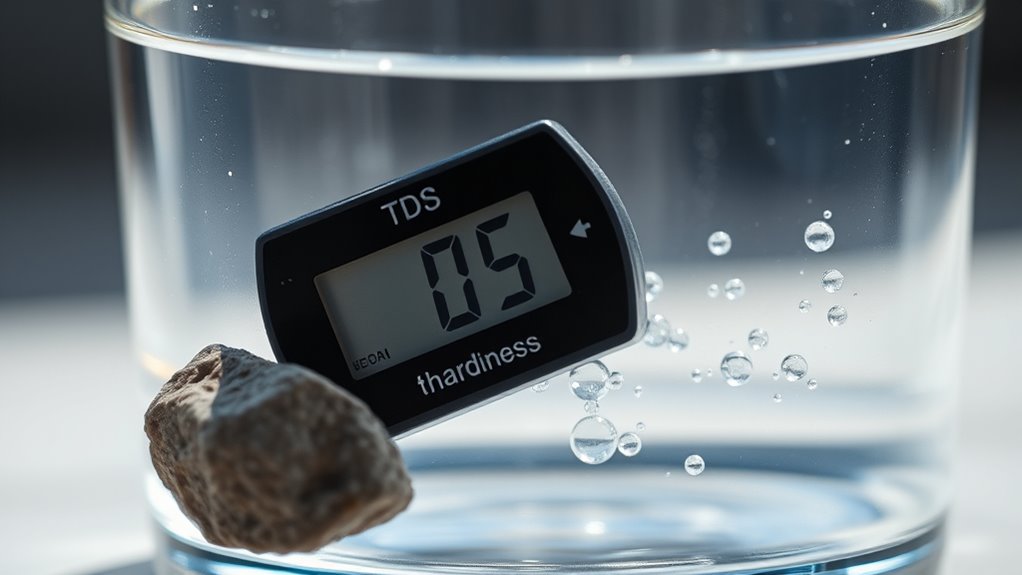
Measuring water hardness and Total Dissolved Solids (TDS) involves specific testing methods that provide quick and accurate results. Water quality testing kits are commonly used for both parameters, often involving test strips or digital meters. For hardness, you typically use a titration method or a test strip that reacts with calcium and magnesium ions, giving you a straightforward reading. TDS is measured with a digital TDS meter that estimates the total concentration of dissolved solids in parts per million (ppm). These measurement techniques are essential for evaluating water quality quickly, helping you decide on water treatment methods. Proper testing ensures you understand your water’s condition and how to address any issues effectively, whether through softening or filtration. Understanding water testing methods is crucial for accurate assessment.
The Causes of Hard Water

Have you ever wondered what causes hard water? It mostly results from the mineral composition dissolved in your water, mainly calcium and magnesium ions. These minerals originate from natural sources like rocks and soil. The water pH also plays a role, affecting how minerals dissolve and interact. Incorporating natural materials such as limestone can further influence mineral levels, contributing to water hardness. Here are the main causes:
- Mineral-rich rocks and soil: Water picks up minerals as it filters through earth layers.
- Calcium and magnesium levels: Higher concentrations increase hardness.
- Geographical location: Areas with limestone or chalk deposits tend to have harder water.
- Water pH: Slightly alkaline water enhances mineral solubility, contributing to hardness.
Understanding these causes helps you grasp why some water feels “hard” and how mineral composition influences it.
Sources of TDS in Water

Ever wonder what contributes to Total Dissolved Solids (TDS) in your water? TDS comes from natural sources and human activities. Minerals like calcium, magnesium, and sodium dissolve into water through soil and rock contact. Runoff from agriculture and urban areas adds salts and chemicals, increasing TDS levels. Water filtration systems can remove some dissolved solids, improving taste and clarity, but not all. Additionally, TDS affects pH balance, impacting water’s acidity or alkalinity. Understanding these sources helps you manage water quality better. For example, dissolved minerals can influence both TDS levels and the water’s pH balance, making it important to monitor their presence. Here’s a quick overview:
| Source | Effect on Water |
|---|---|
| Natural minerals | Contribute to TDS, influence pH balance |
| Human activities | Add salts, chemicals, and pollutants |
| Water filtration | Can reduce certain dissolved solids |
| Soil and rock | Dissolve minerals, affecting TDS levels |
Why Hardness and TDS Matter for Your Water
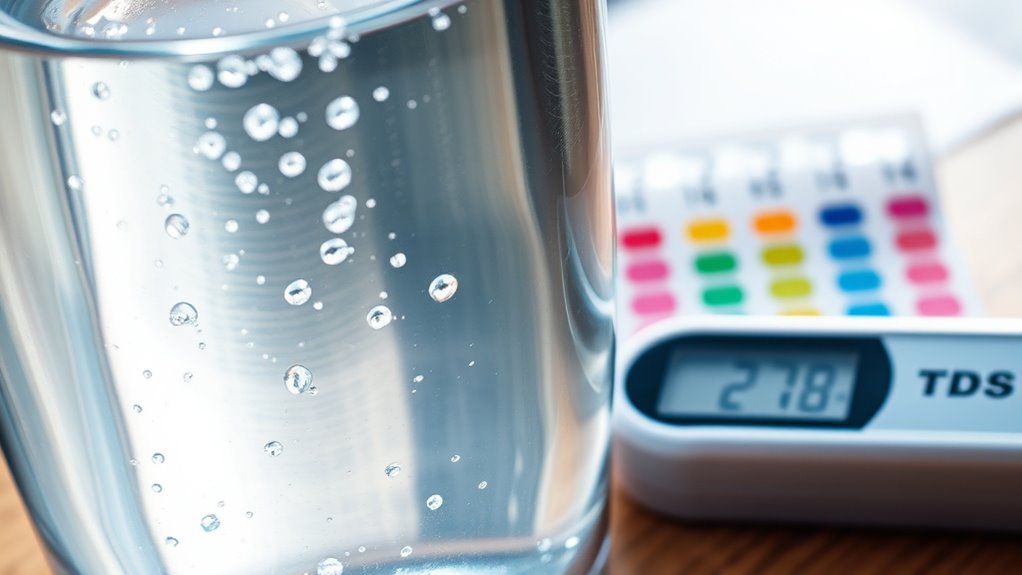
Understanding why hardness and TDS matter is essential because high levels can impact your water’s taste, safety, and how well it works with appliances. Elevated hardness can cause scale buildup, reducing appliance efficiency, while high TDS can make water taste metallic or salty. Monitoring mineral content helps you decide if water softening is needed to prevent damage and improve taste. Water quality plays a crucial role in overall water safety and appliance longevity. Here are four reasons why hardness and TDS matter:
Practical Tips for Managing Hardness and TDS

Managing hardness and TDS effectively involves regular testing and implementing simple solutions like water softeners or filtration systems. Water softening techniques, such as ion exchange filters, remove calcium and magnesium to reduce hardness. Filtration methods, including reverse osmosis and activated carbon filters, lower TDS levels and improve water quality. To keep things straightforward, consider this table:
| Solution Type | Effectiveness | Maintenance Tips |
|---|---|---|
| Water Softening | Reduces hardness | Regenerate salts regularly |
| Filtration Methods | Lowers TDS, improves taste | Change filters as recommended |
| Combined Approach | Best overall water quality | Schedule routine checks |
Additionally, using water treatment systems designed for specific issues can provide targeted solutions for both hardness and TDS management.
Frequently Asked Questions
How Do Hardness and TDS Levels Affect Water Taste?
Hardness and TDS levels directly influence water taste by affecting mineral content and water pH. Higher hardness, caused by minerals like calcium and magnesium, can make water taste chalky or metallic. Elevated TDS, which includes total dissolved solids, often results in a more noticeable mineral flavor or slight bitterness. If these levels are too high or low, your water might taste off, so balancing mineral content helps achieve a better, more invigorating taste.
Can High TDS Indicate Water Contamination?
A high TDS level can sometimes signal water contamination, but don’t jump to conclusions! It’s a warning sign that your water might have excessive minerals or pollutants. You should use water filtration systems for contamination detection, ensuring your water is safe and clean. Remember, not all high TDS means danger, but it’s a strong cue to investigate further and protect your health.
Are There Health Risks Associated With Hard Water?
Hard water itself isn’t typically a health risk, but its mineral composition, mainly calcium and magnesium, influences water pH and can cause skin dryness or irritation. If the mineral levels are excessively high, it might lead to kidney stones or other issues for sensitive individuals. However, for most people, drinking hard water with balanced pH and reasonable mineral content is safe, though it may affect appliance longevity and taste.
What Are the Best Methods to Reduce TDS?
To reduce TDS levels, you should consider water filtration systems like reverse osmosis or deionizers, which effectively remove dissolved solids. These methods help maintain a healthy mineral balance while lowering TDS. Regularly replacing filters ensures peak performance. Keep in mind, balancing TDS and minerals is key for taste and health, so choose a filtration system suited to your water quality needs.
How Often Should I Test My Water’s Hardness and TDS?
Think of testing your water like checking your car’s oil — you want it done regularly to keep things smooth. For water hardness and TDS, test every 3 to 6 months, especially if you notice changes in taste or mineral content. Water filtration systems help maintain balance, but routine testing guarantees your water remains safe and clean. Staying on top of it keeps your water’s mineral content just right.
Conclusion
By understanding hardness and TDS, you can effortlessly fine-tune your water quality. Think of it as a gentle dance—balancing these factors guarantees your water feels just right, whether for daily chores or your favorite beverages. With a few simple tips, you’ll turn what once seemed complex into a harmonious routine. Embrace the journey toward clearer, better-tasting water, making each sip a small celebration of your smart choices.





